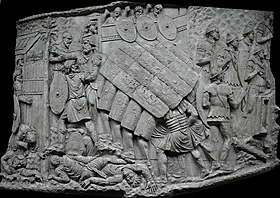Battle of New Carthage
[2] After seven years of mixed fortunes, the Romans hired 20,000 Celtiberian mercenaries to reinforce their regular army and advanced into southern Iberia.
[2][3] The Roman general, and later consul, Gaius Claudius Nero brought over reinforcements in 210 BC and stabilised the situation, holding on to a small lodgement in north-east Iberia.
Alternatively one of the other Carthaginian armies may have come to Hasdrubal's assistance, which would have raised the possibility of the Romans suffering a defeat similar to that of 211 BC.
He learnt it was fortified by strong and high walls 3,700 metres (12,000 ft) long, which faced wide bodies of water for most of their length.
They also employed it as their main arsenal and military harbour for equipment and materiel for the war in Iberia, as well as holding prisoner there many Iberian captives who were hostage for their tribes' good behaviour.
Its commander, Mago,[note 4] had only 1,000 regular troops with which to defend the city, supplemented by what forces he could muster from the local populace; in the event a further 2,000 reasonably effective militia and an unknown number of irregulars.
[36][14] Thirty-five galleys set sail under Scipio's second in command, Gaius Laelius, intending to rendezvous with the main army at New Carthage.
[38] Arriving at New Carthage after a rapid march, the Romans established a camp on a hill in the middle of the isthmus connecting the city with the mainland, opposite the main gate.
[39] Mago kept part of his regular troops in reserve in the citadel, which was in the west of the city, and the balance were posted on or near the southern wall.
[41] During the Punic Wars it was usual for the garrisons of besieged towns and cities to initially give battle outside their walls, regardless of the relative sizes of the attacking and defending forces.
The Romans hung back, causing the initial fighting to develop nearer their camp than the city, perhaps 400 metres (1,300 ft) from the gate.
Even so, given the narrowness of the isthmus, it was not possible for the Romans to readily bring their superior numbers to bear or to outflank the Carthaginians.
This latter involved the attackers climbing the ladders which accompanied them amid missile fire from the defenders, then attempting to fight their way onto the walls.
The Carthaginian defenders were able to initially hold off these assaults and as the survivors of the militia sortie reinforced them on the walls Roman casualties mounted and success looked unlikely.
Concerned, Mago moved reinforcements to the threatened areas, which resulted in the unthreatened northern wall being denuded of defenders.
[47][48] Scipio had maintained a reserve of 500 picked men and held them ready to move against the north wall, anticipating that threats from the other three cardinal directions would lead to its defences being weakened.
According to the traditional translation of this he states that each evening the tide caused the water level in the lagoon north of New Carthage to lower to the extent that it was fordable.
The ancient Roman historian Livy, writing two centuries later, contradicts this – perhaps aware that tides do not operate on a 24-hour cycle – saying that the effect was because of a regular north wind piling up the waters of the lagoon each evening.
[52] Modern historians have offered several interpretations of Polybius's account and suggested different ways in which the level of the lagoon could have been artificially lowered.
Among the latter have been its use as a fish farm or a salt evaporation pond, the level being controlled by sluices on the channel to the west of the city taking advantage of the 0.6 metres (2 ft 0 in) tidal range in the area.
[53] J. H. Richardson, however, dismisses both Polybian and Livian accounts on grounds of hydrological and geological impossibility:[54] tides at New Carthage are too small and slow to have drained the lagoon and there is insufficient space in which to produce a wind which could have blown out the million of litres of water contained.
[63] Scipio joined the fighting for the first time, entering New Carthage with a large force under his direct command and heading for the marketplace in the centre of the city.
[63][64] Scipio sent a force from the marketplace against one of the city's hills where the Carthaginians were fighting on and personally led 1,000 men to the citadel, where he demanded Mago's surrender.
The proceeds of this and the rest of the plunder were divided between all the men of the legions, including those who had not participated in the fighting, the amount dependent on their rank.
The corona muralis, the crown awarded to the first man over the wall, was fiercely contested by a centurion of the Fourth Legion, Quintus Trebellius, and a marine, Sextus Digitius.
[73] Scipio repaired the city's fortifications and shortly after left a substantial garrison and withdrew the rest of his troops to Tarraco.
[76] The unexpected blow caused the Carthaginian generals to fall back on the defensive; continuing to disagree among themselves, they made no attempt to combine their forces even though in total they far outnumbered the Romans.
[5] The Carthaginians were defeated, but Hasdrubal was able to withdraw the majority of his army and prevent any Roman pursuit; most of his losses were among his Iberian allies.
In 207 BC, after recruiting heavily in Gaul, Hasdrubal crossed the Alps into Italy in an attempt to join his brother, Hannibal, but was defeated at the battle of the Metaurus before he could.


